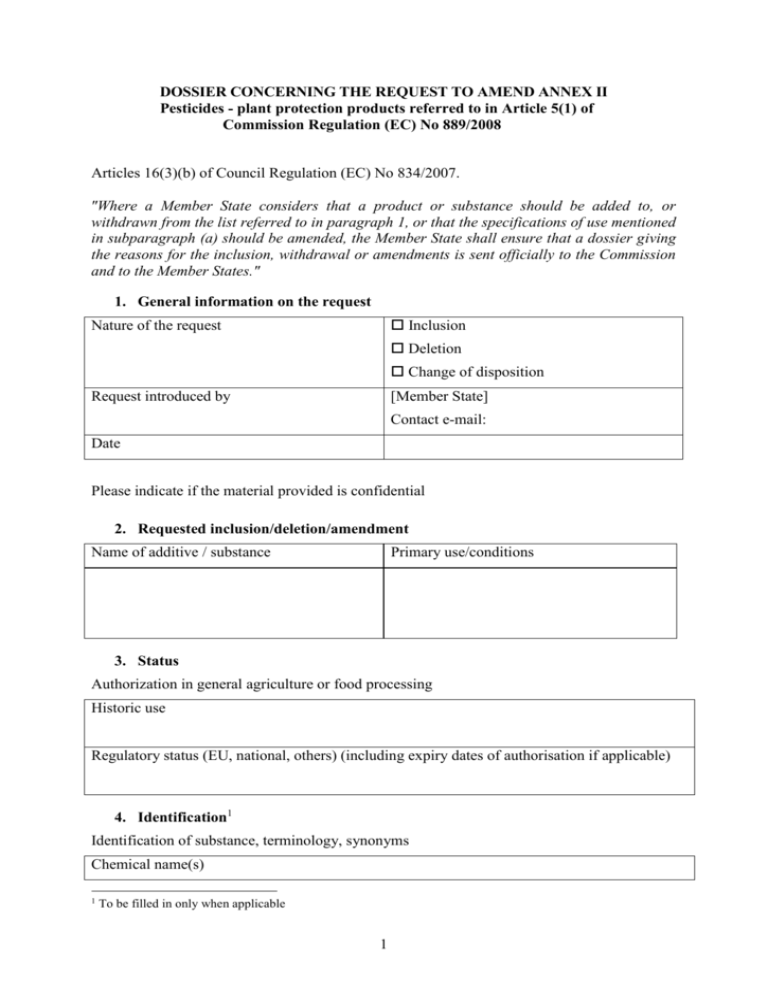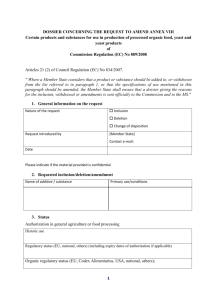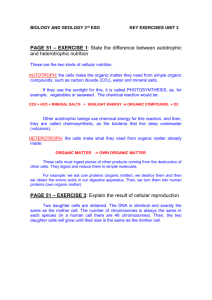13. Annexes
advertisement

DOSSIER CONCERNING THE REQUEST TO AMEND ANNEX II Pesticides - plant protection products referred to in Article 5(1) of Commission Regulation (EC) No 889/2008 Articles 16(3)(b) of Council Regulation (EC) No 834/2007. "Where a Member State considers that a product or substance should be added to, or withdrawn from the list referred to in paragraph 1, or that the specifications of use mentioned in subparagraph (a) should be amended, the Member State shall ensure that a dossier giving the reasons for the inclusion, withdrawal or amendments is sent officially to the Commission and to the Member States." 1. General information on the request Inclusion Nature of the request Deletion Change of disposition Request introduced by [Member State] Contact e-mail: Date Please indicate if the material provided is confidential 2. Requested inclusion/deletion/amendment Name of additive / substance Primary use/conditions 3. Status Authorization in general agriculture or food processing Historic use Regulatory status (EU, national, others) (including expiry dates of authorisation if applicable) 4. Identification1 Identification of substance, terminology, synonyms Chemical name(s) 1 To be filled in only when applicable 1 Other names Trade name CAS code (Chemical Abstracts Systematic Names) Other code(s) 5. Aspects related to the relevance and priority of the request Geographical relevance (Member States, regions, …) Socio-economic relevance (acreage, turnover, number of stakeholders affected, … ) Sectors affected Stakeholder engagement/consultation in dossier preparation Aspects of international harmonization / market distortion A (possible) authorization leads to amendment(s) in the respective Annex2 Other aspects justifying high priority, such as • relevance for the development of a new organic production sector, • addressing of a newly upcoming problem in production or a quarantine organism, • addressing a recent development in agricultural policies, • addressing a new trend in consumer preferences/nutritional habits or new developments in food technology, • addressing a declared goal of organic farming. 6. Characterisation Raw materials, methods of manufacture Composition Active ingredients (as far as known) Relevant physical/chemical properties including solubility Origin of raw materials (including aspects of mining/harvesting them), production methods 2 It should be carefully analysed whether the specific use of a substance is already (impicitly) authorized or not. This is to avoid the following conclusion: "The Group considers that the use of … is in line with the objectives, criteria and principles of the organic regulation. There is no need for amendment of the specific conditions of Annex …" 2 7. Specification of use Agronomic use Type of use (fungicide, insecticide, repellent, etc.) Crops treated and pests/diseases controlled Formulation Application method Dosage and number of applications Stage of plant development when the substance is applied Physiological effect, mode of action Side-effects on crops 8. Reasons for the inclusion, withdrawal or amendments Explain the need for the proposed pesticide What alternative solutions are currently authorised or possible? Is there any traditional use or precedents in organic production? 9. Consistency with objectives and principles of organic production Please use the checklist in Annex A to this dossier to indicate consistency with objectives and principles of organic production, as well as criteria and general rules, laid down in Council Regulation (EC) 834/2007 Title II and Title III as applicable. 10. Impact Environment Animal health and welfare Human health Food quality and authenticity 3 11. Other aspects Various aspects, further remarks 12. References 13. Annexes 4 Annex A CHECKLIST FOR CONSISTENCY with objectives and principles of organic production with reference to specific articles in the organic regulation Criteria Specific articles in Reg. 834/2007 Exclude the use of GMOs and products produced from or by GMOs Enhances the health of soil, water, plants and animals High level of biodiversity Makes responsible use of energy and the natural resources, such as water, soil, organic matter and air Aim at producing products of high quality Aim at producing a wide variety of foods and other agricultural products……goods produced by the uses of processes that do not harm the environment, human health, plant health or animal health and welfare Use living organisms and mechanical production methods Limited to natural or naturally-derived substances For chemically synthesized inputs: appropriate management practices do not exist For chemically synthesized inputs: organic, natural or naturally-derived alternative substances are not available on the market Art. 4(a)(iii); Art. 9(1) Art. 3(a)(i) Art. 3(a)(ii) Art. 3(a)(iii) Art. 3(b) Art. 3 (c) Art. 4(a)(i) Art. 4(b)(ii) Art. 4(c)(i) Art. 4(c)(ii) 5 Fulfilled? Yes / no / not applicable Brief qualification Criteria Specific articles in Reg. 834/2007 For chemically synthesized inputs: use of organic, natural or naturally-derived alternative substances contributes to unacceptable environmental impacts Maintenance of plant health primarily by preventative measures, such as resistant species/varieties, appropriate crop rotations, cultivation techniques, mechanical and physical methods, thermal processes and the protection of natural enemies of pests All plant production techniques used shall prevent or minimise any contribution to the contamination of the environment The corresponding use is authorised in general agriculture […] Their use is necessary for sustained production and essential for its intended use All products and substances shall be of plant, animal, microbial or mineral origin … … except where products or substances from such sources are not available in sufficient quantities or qualities or if alternatives are not available Their use is essential for the control of a harmful organism or a particular disease for which other biological, physical or breeding alternatives or cultivation practices or other effective management practices are not available Art. 4(c)(iii) Art. 5(f); Art. 12 (1)(g) Art. 12 (1)(f) Art. 16 (1) Art. 16(2)(a) Art. 16 (2)(b) Art. 16 (2)(b) Art. 16 (2)(c)(i) 6 Fulfilled? Yes / no / not applicable Brief qualification Criteria Specific articles in Reg. 834/2007 If products are not of plant, animal, microbial or mineral origin and are not identical to their natural form, they may be authorised only if their conditions for use preclude any direct contact with the edible parts of the crop Products and substances to be withdrawn or their use amended/ limited Others: please specify Art. 16(2)(c)(ii) Art. 16(3)(b) 7 Fulfilled? Yes / no / not applicable Brief qualification







